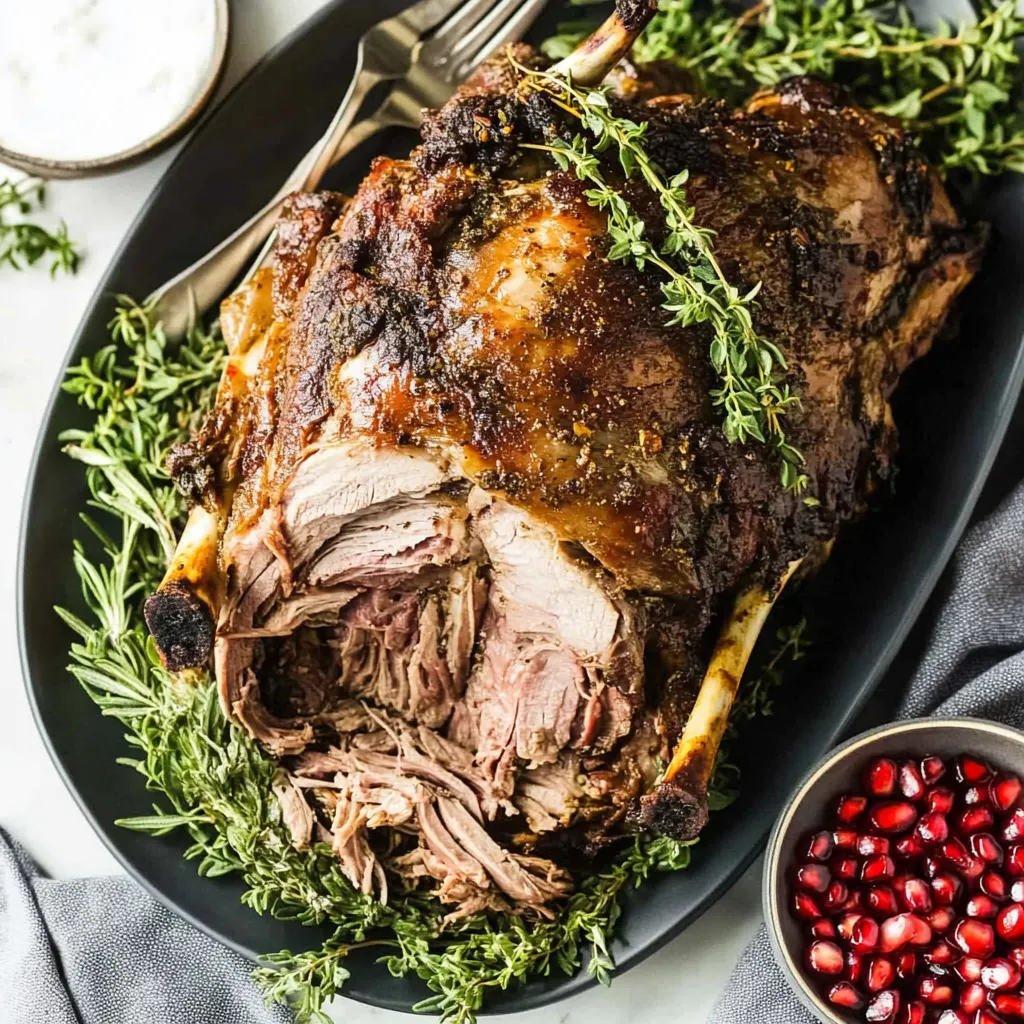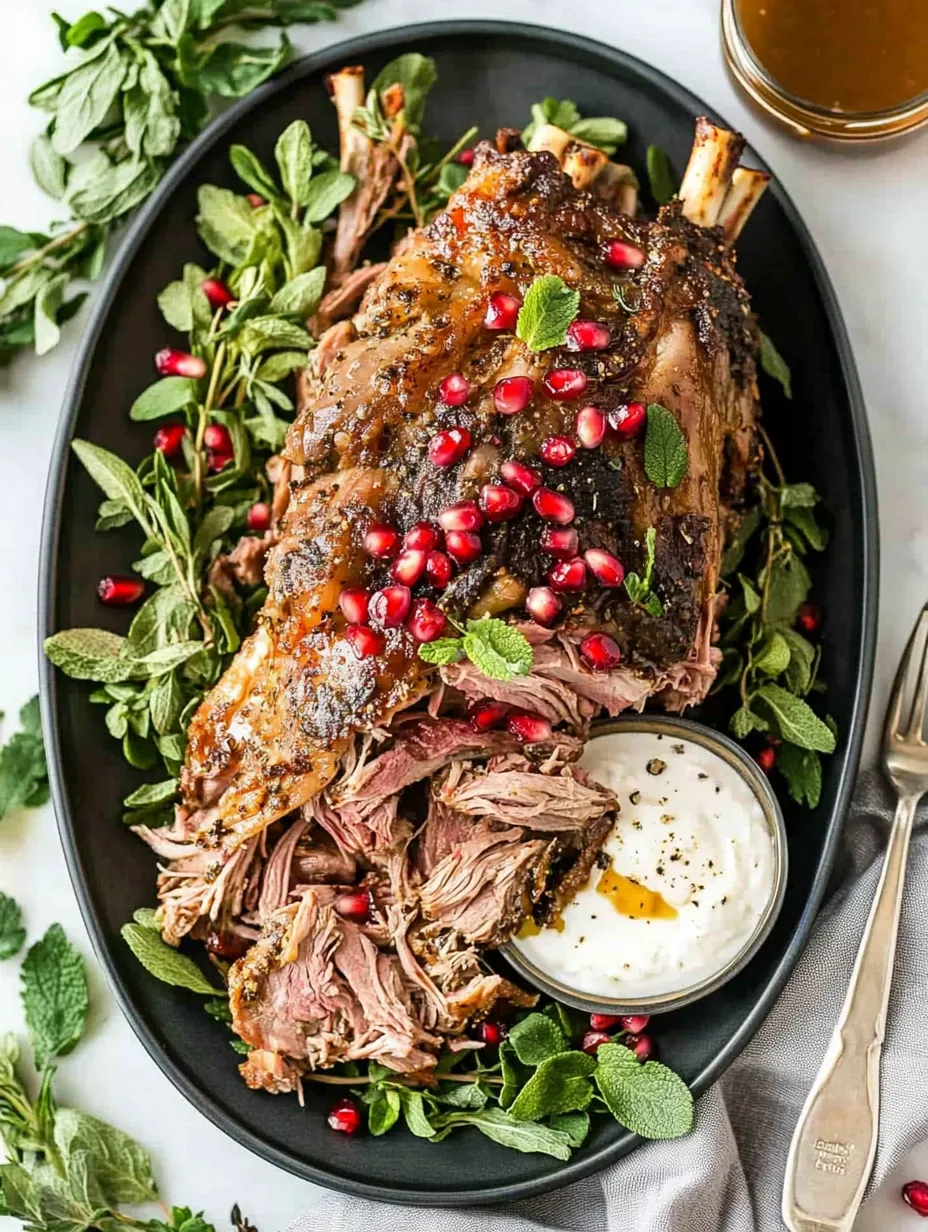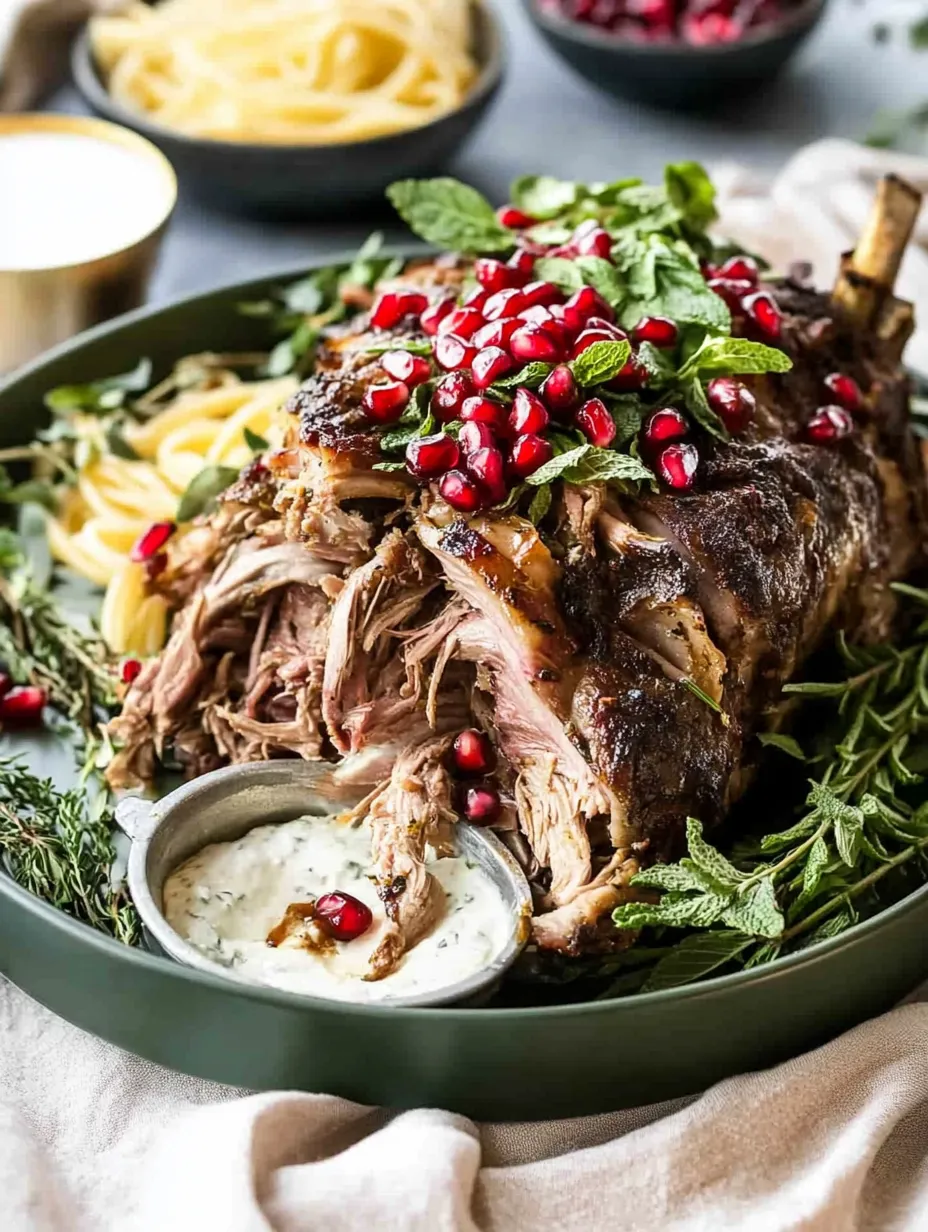 Pin it
Pin it
This extraordinary leg of lamb transforms from humble joint to transcendent feast through patient, gentle heat that renders the meat so tender it practically melts from the bone with the mere suggestion of a fork. The magic happens during those long, slow hours when the collagen gradually converts to gelatin, creating succulence that simply cannot be achieved through quicker methods. I perfected this recipe after years of experimenting with various techniques to achieve that elusive combination of falling apart tenderness while maintaining the distinctive lamb flavor.
Sunday Showstopper
My journey with this recipe began after a memorable meal in a small family owned Greek taverna where the lamb arrived at the table so tender it could be pulled apart with spoons. What started as an attempt to recreate that experience evolved into our family's most requested celebration meal. Even my mother, typically critical of others cooking her specialty dishes, asks for my recipe. The first time I served this to guests, conversation stopped entirely for several minutes while everyone focused intently on their plates, perhaps the highest possible culinary compliment.
Superior Ingredients
- Leg of Lamb (2.5kg/5.5lbs): The perfect cut that balances meat and fat with interconnected tissue that transforms during slow cooking to create extraordinary tenderness
- Fresh Garlic (8 cloves): Provides essential aromatic pungency that mellows during long cooking while infusing the meat from within
- Rosemary Sprigs (4 fresh): Contribute pine like aromatic oils that penetrate the meat, creating that distinctive Mediterranean flavor profile
- Quality Olive Oil (4 tablespoons): Forms the foundation of the Mediterranean flavor palette while helping create the essential initial sear
- Whole Lemons (2): Provide brightness through their juice and aromatic oils from their zest that cut through the richness of the lamb
- Spanish Onions (2 large): Create a flavorful bed that prevents sticking while slowly caramelizing to add sweetness to the pan juices
- Chicken Stock (500ml/2 cups): Provides essential moisture while contributing savory depth beyond what water could offer
- Greek Yogurt (2 cups): Creates the cooling, tangy sauce that perfectly complements the rich, savory lamb
 Pin it
Pin it
Roasting Technique
- Foundational Preparation:
- Begin with the lamb at room temperature, removing it from refrigeration approximately 1 hour before cooking. This critical step ensures even cooking from exterior to interior. Pat the lamb completely dry with paper towels, as excess moisture prevents proper browning. Using a sharp paring knife, make approximately 20 small, deep incisions throughout the meat, spacing them evenly. Slice 8 garlic cloves in half lengthwise and cut 4 sprigs of rosemary into 2cm segments. Insert a piece of garlic and rosemary into each incision, pushing them deep into the meat where they'll infuse flavor throughout cooking. Drizzle the lamb with 2 tablespoons olive oil, then season generously with 2 teaspoons sea salt and 1 teaspoon freshly ground black pepper, massaging the seasonings into every surface. This advance flavoring creates multiple layers of taste development during the long cooking process.
- Initial Browning:
- Preheat your oven to 160°C/325°F with a rack positioned in the lower third. Place a large Dutch oven or heavy roasting pan over medium high heat and add the remaining 2 tablespoons olive oil. When the oil shimmers but before it smokes, carefully place the seasoned lamb in the hot pan. Brown thoroughly on all sides, taking approximately 3 to 4 minutes per side to develop a rich, golden crust. This browning process creates the Maillard reaction, where proteins and sugars transform to create hundreds of new flavor compounds that will infuse the meat during long cooking. The resulting crust also helps seal in juices while providing beautiful color contrast to the tender interior meat. Once browned on all sides, temporarily remove the lamb from the pan and set aside.
- Aromatic Foundation:
- Reduce the heat to medium and add 2 large Spanish onions, thickly sliced, to the hot pan with the rendered fat and browned bits from the lamb. Sauté briefly until they begin to soften, approximately 2 minutes, using a wooden spoon to scrape up the flavorful fond from the bottom of the pan. Cut 2 lemons into quarters and add to the pan along with 1 tablespoon dried oregano, 2 additional sprigs of rosemary, and 2 cups chicken stock. These aromatics and liquid create the flavor environment that will surround the lamb throughout its long cooking journey. Return the browned lamb to the pan, placing it on top of the bed of onions, which prevents the meat from sticking to the bottom while creating space for juices to collect.
- Patient Transformation:
- Cover the Dutch oven with its lid or the roasting pan tightly with heavy duty aluminum foil, creating a sealed environment that traps moisture and allows the lamb to self baste. Place in the preheated oven and allow time to work its magic, cooking for approximately 5 hours. This extended, gentle cooking breaks down the tough connective tissues while maintaining moisture, resulting in exceptional tenderness without dryness. After 2 hours, baste the lamb with the accumulated juices, then recover and continue cooking. Repeat this basting process every hour thereafter, which redistributes flavors and ensures even moisture distribution. The lamb is ready when it literally falls apart when prodded with a fork, typically after about 5 hours, though the exact time depends on the size and shape of your specific cut.
- Finishing Excellence:
- While the lamb completes its final cooking, prepare the accompanying yogurt sauce. Combine 2 cups Greek yogurt with 2 cloves minced garlic, the juice of 1 lemon, 3 tablespoons finely chopped fresh mint, 1/2 teaspoon salt, and 1/4 teaspoon freshly ground black pepper. Stir thoroughly and refrigerate until serving, allowing the flavors to meld. When the lamb has reached perfect tenderness, remove from the oven and transfer it to a serving platter. Allow it to rest, loosely tented with foil, for at least 20 minutes before serving. This resting period allows the juices to redistribute throughout the meat rather than rushing out when cut. Strain the pan juices into a gravy boat or serving bowl, skimming excess fat if desired. The concentrated flavor of these juices provides the perfect natural sauce for the lamb. Serve the tender meat alongside the yogurt sauce, offering both options for diners to enjoy.
I particularly appreciate how this lamb transforms a gathering into a memorable occasion. Growing up, lamb appeared on our table primarily for Easter, surrounded by family tradition and anticipation. This recipe captures that celebratory essence while being accessible enough for less formal occasions. When teaching my nephew basic cooking techniques, this became one of our first major projects, building his confidence through the forgiving nature of slow cooking. The look of pride on his face when our family praised his efforts created kitchen memories that transcend the meal itself. During one particularly memorable dinner party, a friend who claimed to dislike lamb asked for seconds and then quietly requested the recipe before leaving, perhaps the most sincere culinary compliment possible.
Serving Inspiration
This versatile lamb welcomes numerous serving approaches depending on the occasion and season. For traditional Sunday lunches, carve thick slices and serve alongside roasted potatoes, glazed carrots, and mint sauce for a classic presentation. During warmer months, consider shredding the tender meat and serving with warmed pita bread, fresh cucumber, tomatoes, and the yogurt sauce for Mediterranean style wraps that showcase the meat's versatility. Leftover lamb transforms wonderfully into flavorful sandwiches on crusty bread with a spread of the yogurt sauce and fresh greens. For elegant dinner parties, serve smaller portions over creamy polenta or mashed potatoes with the strained, reduced pan juices spooned over top. The meat also works beautifully as a topping for grain bowls or salads when looking for lighter serving options that still feature its remarkable flavor and texture.
Creative Adaptations
This foundation recipe welcomes numerous variations based on preference or available ingredients. For Moroccan influences, incorporate 1 teaspoon each of ground cumin, coriander, and cinnamon into the initial seasoning, perhaps adding dried apricots to the roasting pan during the final hour. Those preferring less pronounced lamb flavor might add a tablespoon of pomegranate molasses to the roasting liquid, which introduces subtle sweetness while tempering the gaminess. Herb variations create entirely different profiles, with thyme and sage offering alternatives to the traditional rosemary. The yogurt sauce adapts beautifully to include finely diced cucumber for tzatziki style accompaniment, or substitute fresh dill for the mint for a different aromatic direction. For those enjoying heat, incorporate harissa paste into the initial meat seasoning or offer it as a condiment alongside the yogurt sauce, creating pleasant contrast between cool and spicy elements.
 Pin it
Pin it
Storage Strategy
This lamb maintains excellent quality when properly stored, sometimes developing even deeper flavor after a day in the refrigerator. Allow any leftover meat to cool completely before refrigerating in airtight containers with some of the pan juices to maintain moisture. Properly stored, the lamb keeps beautifully for up to three days, making it ideal for intentional leftover planning. For reheating, place the meat and juices in a covered dish in a 150°C/300°F oven until just warmed through, approximately 15 to 20 minutes, being careful not to overcook which would dry the previously perfect texture. For longer preservation, shred the meat and freeze in portion sized containers covered with strained pan juices for up to two months. Thaw overnight in the refrigerator before gently reheating. The yogurt sauce keeps separately for up to two days refrigerated, though the fresh herb flavor diminishes slightly over time. Consider preparing a fresh batch for serving with leftover lamb to maintain optimal flavor contrast.
After perfecting this recipe through countless iterations, I've come to appreciate slow roasted lamb as more than just delicious food but rather as a lesson in culinary patience. What begins as a tough cut transforms through gentle heat and time into something transcendent that could never be rushed. The beautiful simplicity of quality ingredients treated with respect reminds us that exceptional cooking often requires restraint rather than complexity. While many impressive dishes demand constant attention and precise timing, this lamb offers the rare combination of spectacular results with relaxed, forgiving preparation. It stands as proof that sometimes the greatest culinary achievements come not from elaborate techniques but from understanding the transformative power of patience and selecting the right ingredients to showcase it.
Frequently Asked Questions
- → Can I use a different cut of lamb for this slow roasting method?
- Yes, while this recipe is designed for a leg of lamb, the slow roasting method works beautifully with several other cuts: 1) Lamb shoulder is an excellent alternative - it has even more connective tissue than leg, making it perfect for slow roasting and possibly even more flavorful. 2) A half leg or lamb shank portions work well if you're serving fewer people. 3) For a boneless option, a lamb shoulder or boneless leg will work, though you may need to reduce cooking time slightly by 30-60 minutes. 4) Avoid lean cuts like rack of lamb or loin for this method, as they're better suited to faster cooking at higher temperatures. With any substitution, the key indicator of doneness is tenderness - the meat should easily pull apart with a fork regardless of internal temperature.
- → Do I need to marinate the lamb before slow roasting?
- Marinating isn't necessary for this slow-roasted lamb recipe, which is one of its advantages. The extended cooking time allows the seasonings to deeply penetrate the meat, essentially accomplishing what a marinade would do. However, if you'd like to enhance the flavor profile further, you can dry brine the lamb by applying the salt, pepper, and dried herbs 24 hours before cooking and refrigerating uncovered. This will further improve moisture retention and flavor development. If you do choose to use a wet marinade (perhaps with wine, lemon juice, and herbs), limit it to 12 hours maximum to prevent the acids from affecting the meat's texture negatively. Just ensure you thoroughly pat the meat dry before browning to achieve a good sear.
- → What's the best way to know when the lamb is perfectly done?
- For this slow-roasted method, traditional temperature guidelines don't apply as they would for regular roasting. After 5 hours at low temperature, the lamb will be well beyond the standard temperature readings but incredibly tender rather than tough. The most reliable indicator is texture - the meat should effortlessly pull apart with a fork and practically fall off the bone. If you do use a thermometer, expect readings around 195-205°F (90-96°C), much higher than the 145°F (63°C) recommended for medium-rare lamb cooked by traditional methods. If after 5 hours the meat doesn't easily shred, return it to the oven for additional 30-minute increments until it reaches that perfect fork-tender stage. Remember that factors like the exact size of the lamb leg and individual oven variations can affect cooking time.
- → Can I make this recipe in a slow cooker or pressure cooker instead?
- Yes, this recipe adapts well to both slow cookers and pressure cookers: For a slow cooker: Brown the lamb as directed, then transfer to the slow cooker along with the other ingredients. Cook on LOW for 8-10 hours or HIGH for 5-6 hours until fork-tender. For a pressure cooker/Instant Pot: Brown the lamb using the sauté function, then add remaining ingredients. Cook on HIGH pressure for 90 minutes for a 5.5 lb leg, followed by a 15-minute natural release. While both methods work well, they produce slightly different results than oven roasting. The slow cooker version will be extremely tender but won't develop the same roasted flavor. The pressure cooker version saves significant time but may not have quite the same depth of flavor. For either method, you might want to reduce the liquid amount to 2 cups since less evaporation occurs.
- → What are some good side dishes to serve with this lamb?
- This Mediterranean-inspired lamb pairs beautifully with sides that complement its rich, aromatic flavors: 1) Roasted vegetables like potatoes, carrots, and parsnips can cook alongside the lamb during the last 1-2 hours. 2) Greek-style lemon potatoes with oregano make a traditional pairing. 3) A fresh Greek salad with tomatoes, cucumber, feta, and olives provides a bright contrast. 4) Tabbouleh or other grain salads with fresh herbs work wonderfully. 5) Warm pita bread or flatbreads are perfect for sopping up the flavorful juices. 6) Tzatziki makes an additional or alternative sauce option. 7) Steamed or sautéed greens such as spinach or kale balance the richness. 8) Roasted eggplant or a Mediterranean vegetable medley complements the lamb's flavors. For a complete feast, offer a selection of mezze starters like hummus, baba ganoush, and stuffed grape leaves.
- → How can I use the leftovers from this roast lamb?
- The tender nature of this slow-roasted lamb makes the leftovers incredibly versatile: 1) Lamb sandwiches or wraps with the yogurt mint sauce, fresh vegetables, and perhaps some feta cheese. 2) Shepherd's pie - combine the shredded lamb with gravy and vegetables, topped with mashed potatoes. 3) Mediterranean lamb hash with potatoes, peppers, and a fried egg on top for breakfast or brunch. 4) Lamb pasta - toss with pasta, some of the reduced cooking liquid, and freshly grated Parmesan. 5) Lamb tacos or quesadillas with appropriate spices and toppings. 6) Greek-style lamb soup with orzo, vegetables, and lemon. 7) Lamb and vegetable stew - simmer with additional stock and root vegetables. 8) Lamb salad with arugula, roasted vegetables, and a lemon vinaigrette. The meat will keep in the refrigerator for up to 3 days or can be frozen for up to 2 months.
